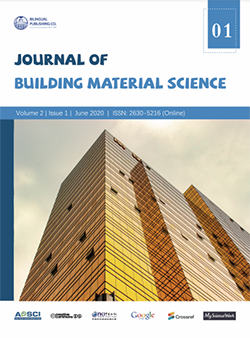
The Effect of Various Polynaphthalene Sulfonate Based Superplasticizers on the Workability of Reactive Powder Concrete
DOI:
https://doi.org/10.30564/jbms.v2i1.2731Abstract
A superplasticizer is a type of chemical admixture used to alter the workability (viscosity) of fresh concrete. The workability of fresh concrete is often of particular importance when the water-to-cement (w/c) ratio is low and a particular workability is desired. Reactive Powder Concrete (RPC) is a high-strength concrete formulated to provide compressive strengths exceeding 130MPa and made of primarily powders. RPC materials typically have a very low w/c, which requires the use of a chemical admixture in order to make the material workable for placing, handling and consolidating. Superplasticizer are commonly used for this purpose. Superplasticizers are developed from different formulations, the most common being Polynaphthalene Sulfonate (PNS), Polymelamine Sulfonate (PMS) and Polycarboxylate Ether (PCE). This study investigates the impact of various PNS based superplasticizers on the compressive strength and rheological performance of a RPC mixture. Six different types of PNS based superplasticizers were used; three of various compositional strengths (high, medium, low range) from a local provider, and three of the same compositional strengths (high, medium, low) from a leading manufacturer. Specific properties assessed were the superplasticizers viscosity, concrete workability through the mortar-spread test, concrete rheology, and 7, 14, and 28 day RPC compressive strengths. Two mixtures were produced with two w/cm (0.20 and 0.15), which would subsequently increase the amount of superplasticizer needed, from 34.7L/m3 to 44.5L/m3. The results show that the name brand high range composition produced the overall highest spread, lowest viscosity, and a highest compressive strength at all ages tested. However, the local provider outperformed the name brand in the mid and low range compositions. Additionally, the rheology test also demonstrated that the name brand high range, and RPC produced with the name brand high range, had a lower viscosity at all angular speeds than the others tested.
Keywords:
Reactive Powder Concrete; Ultra High Strength Concrete; Workability; Superplasticizer;References
[1] ASTM C494, “Standard Specifications for Admixtures in Concrete”, ASTM International, ASTM Standard C 494 (2020), West Conshohocken, Pa, USA, 2020, https://www.astm.org.
[2] Torres, A., Aguayo, F., Allena, S., Ellis, MG, “Investigating the Rheological Properties of Ultra High Strength Concrete Made with Various Superplasticizers” Journal of Advances in Science and Engineering 2019; 11(2)
[3] Alsadey, S., “Effect of Superplasticizer on Fresh and Hardened Properties of Concrete” Journal of Agricultural Science and Engineering Vol. 1, No. 2, 2015, pp. 70-74
[4] Rendon Diaz Miron, L., & Lara Magaña, M. (2015). Superplasticizer for High Strength Concrete. MRS Proceedings, 1768, Imrc2014-6d-019. DOI:https://doi.org/10.1557/opl.2015.324
[5] Mardani-Aghabaglou, A., Tuyan, M., Yılmaz, G., Arıöz, Ö, & Ramyar, K. (2013). Effect of different types of superplasticizer on fresh, rheological and strength properties of self-consolidating concrete. Construction and Building Materials, 47, 1020-1025. DOI:https://doi.org/10.1016/j.conbuildmat.2013.05.105
[6] ASTM C150,” Standard Specification for Portland Cement,” ASTM International,” ASTM Standard C150-20 (2020), West Conshohocken, Pa, USA, 2020, https://www.astm.org.
[7] ACI Committee 239, “239R-18: Ultra-High Performance Concrete: An Emerging Technology Report” 2018 American Concrete Institute, p1-41, V1
[8] Torres, A., Aguayo, F., Allena, S., “Developing Sustainable Ultra High Strength Concrete Mixtures Using Spent Foundry Sand” Journal of Civil Engineering and Architecture, 2019, 13, 343-352
[9] E. Shaheen and N. G. Shrive, “Optimization of mechanical properties and durability of reactive powder concrete,” ACI Materials Journal, vol. 103, no. 6, pp. 444–451, 2006.
[10] Aguayo, F., Torres, A., Talamini, T.U, and Whaley, K.U, “Investigation into the Heat of Hydration and Alkali Silica Reactivity of Sustainable Ultrahigh Strength Concrete with Foundry Sand,” Advances in Materials Science and Engineering, vol. 2017, Article ID 2096808, 11 pages, 2017. DOI:https://doi.org/10.1155/2017/2096808
[11] NF EN12390-3. Testing hardened concrete – Part 3: Compressive strength of test specimens; 2019. 18p.
[12] ASTM C109 “Standard Test Method for Compressive Strength of Hydraulic Cement Mortars (Using 2-in. or [50-mm] Cube Specimens),” ASTM Standard C 109-16a (2019) West Conshohocken, Pa, USA, 2019, https://www.astm.org.
[13] ASTM C1437 “Standard Test Method for Flow of Hydraulic Cement Mortars” ASTM International,” ASTM Standard C 39-15a (2020), West Conshohocken, Pa, USA, 2020, https://www.astm.org.
Downloads
How to Cite
Issue
Article Type
License
Copyright © 2021 Anthony Torres, Federico Aguayo, Srinivas Allena, Michael Ellis

This is an open access article under the Creative Commons Attribution-NonCommercial 4.0 International (CC BY-NC 4.0) License.







 Anthony Torres
Anthony Torres





